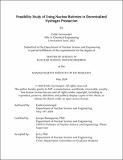Feasibility Study of Using Nuclear Batteries in Decentralized Hydrogen Production
Author(s)
Germonpré, Emile
DownloadThesis PDF (6.119Mb)
Advisor
Buongiorno, Jacopo
Terms of use
Metadata
Show full item recordAbstract
Nuclear batteries (NBs) are a class of factory-fabricated, autonomously operated microreactors that have the potential to form an extremely versatile clean energy platform. However, they have a high levelized cost of electricity (LCOE), so more insights are needed into how to leverage their unique features to make attractive projects. To that goal, this work investigates using NBs in decentralized hydrogen production to better understand their true value proposition and applicability. The work is part of a larger project in which using NBs for offshore power generation is also investigated. Both the hydrogen production and offshore power generation reports are available as CANES publications [1], [2].
The focus is exclusively on economics, as I do not foresee any technical challenges to this application. By evaluating nearly 100 different projects, I highlight five factors needed for competitiveness; four of which directly impact the cost of hydrogen production, as shown in Figure 1:
1. The facility size to dilute the cost of providing site security
2. The capital cost decrease over time due to the economies of multiples
3. Policy and regulation through clean energy subsidies and the requirement of on-site guards.
4. The efficient leveraging of NB’s high-temperature heat delivery
The fifth factor relates to the benefit of colocation of production and demand, as it can save on the large hydrogen delivery costs. The delivery cost savings can make the best-performing semi-centralized NB projects competitive with centralized production in contexts where transmission from the centralized plants is not cheap. On the other hand, the distribution cost saving of on-site production is not decisive according to my calculations. However, hydrogen delivery costs are highly context-dependent. So, further work is needed to address other delivery contexts - e.g., rural communities – and to better understand under which circumstances NBs can provide significant delivery cost saving.
Date issued
2024-05Department
Massachusetts Institute of Technology. Department of Nuclear Science and EngineeringPublisher
Massachusetts Institute of Technology